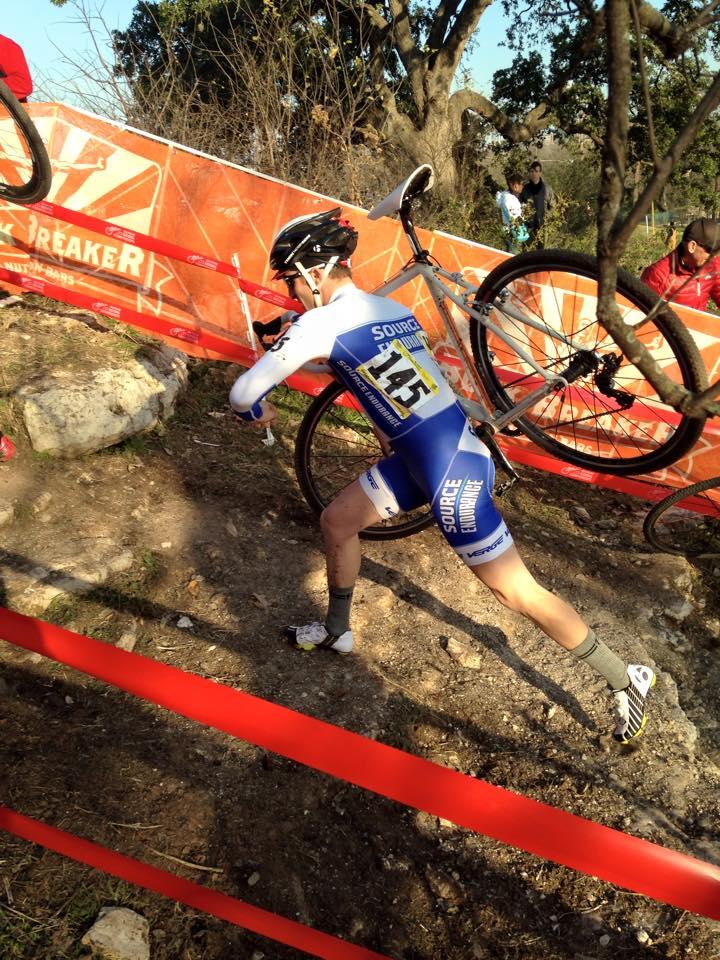Anaerobic Capacity's Role in Cyclocross Racing

When you are pedaling in a cyclocross race, how often are you thinking “man I’m barely anaerobic….this is sustainable…” Pretty much never. When deep in a cyclocross race you are going from coasting, to a near max effort, to coasting, to running anaerobically, to deeply anaerobic again. While we can name 10 things that will make you a faster cyclocross racer, functional reserve capacity and anaerobic capacity training are key.
In cyclocross, we see huge amounts of work done over anaerobic capacity. Anaerobic means “without oxygen.” Physiologically when your body is working anaerobically, the oxygen demands by your muscles to maintain power production is higher than the capacity of oxygen your lungs and blood can carry to your muscles. This is where the light bulb goes off for some people that are self coached and I start getting questions. “If cyclocross is anaerobic why don’t I make my lungs stronger with an ‘altitude mask‘ and “why don’t I do breathing exercises to increase lung capacity” The answer is that your lung capacity is not the limiting factor.
The limiting factor is your ability to take the oxygen from your lungs to your blood. If you want to increase that without performance enhancing drugs, you have to train. Specific training does a number of things; it increases your blood values, blood volume, hematocrit and glycogen accumulation. These adaptations to training result in more power for longer durations.
Now that we understand there are no shortcuts like training masks or drugs, let’s look at some files and figure out what you should be doing and changing in your training.
Here is a file of a larger regional cyclocross event in the Pro 1/2 field:

Looking at the grid, despite this rider’s FTP being around 320 watts, we see a huge amount of time above FTP in an anaerobic state.

In the power distribution chart we see this rider spend about 17 minutes ABOVE FTP. That is a huge amount of time anaerobically and to get to be able to do this we need specific workouts in these ranges on top of a strong threshold aerobic base.
Tracking FRC vs Threshold through the cyclocross season

Once we start with these specific workouts for an already strong and fit rider to increase their anaerobic capacity we can track their progress though other metrics. Above is a chart that tracks FRC or functional reserve capacity, the total amount of work you can do during continuous exercise above your FTP before fatigue occurs. Reading this definition and connecting it back to physiology we can connect the dots and look at FRC as how long and how anaerobic you can go for a certain amount of energy. It also tracks Pmax which unlike a 1 or 5 second max power it’s a full pedal revolution. It also tracks measured FTP. What we want to see as we hopefully do the right workouts with the right amount of fatigue is a graph like this where FRC is increasing. This rider had a peak for a national event at the dotted line and then promptly got injured in a crash making him take time off the bike hence the drop in all metrics directly after the dotted line.
You may also notice a stagnant FTP or even a drop in FTP. Its very hard to maintain volume and intensity. Generally, even in road racers, you will see a drop in FTP during a taper or peak or whenever you focus on anaerobic intervals. It does not mean a drop in fitness but more that there are not going to be points for your WKO program to take to see a higher mFTP until your race.
Another way we can use this FRC metric, which is one of my favorites and new to WKO 4 is by knowing our athletes FRC and pushing to that limit or just before and then having shorter recovery periods when building workouts. Usually these are very intense workouts, as coaches it’s fun to write them but I don’t envy the athlete on this day and I usually get a pretty grumpy email along the lines of “that workout kicked my a$$”
Working on an interval set to raise this rider’s FRC, we know he can do about 15 kj anaerobically. This is not exact of course, it’s not like we can have this rider do any effort above 310 watts as he counts Kilojoules on his Garmin before going back to recovery pace but we can use it to make an interval set that with reps and rest will get him a near perfect overload stimulus. Since 1 KJ (kilojoule) = 1000 watt second. Let’s make poor athlete do 1000 watts for 15 seconds over and over and over. Not possible. But 400 watts, for this athlete 130% of threshold is in his V02 range and anaerobic. 400 watts for about 30 seconds would be close to 15 kj. If we mix this principle with what the riders strength and weakness chart says….

Since this rider has a weakness at 30 seconds, 400 watt, 30 second intervals pushing his current FRC sounds perfect for this individual but not for everyone. This is the key to individual coaching over blanket coaching plans. How much rest will depend on his heart rate reaction and fitness.

Zack Allison’s affinity for cycling started when he was 14 racing on the East Coast and his enjoyment of the sport lead him to pursue his BSEd in Exercise Science from Colorado State University, in Fort Collins, Colorado. He currently races for Elevate Pro Cycling, a UCI continental men’s road team. Growing up in the sport with many great mentors, he loves to pay it forward, using a combination of education and race experience. You can often find him zooming around on Fort Collin’s many gravel roads or on its countless mountain bike trails. Learn more about Zack.
